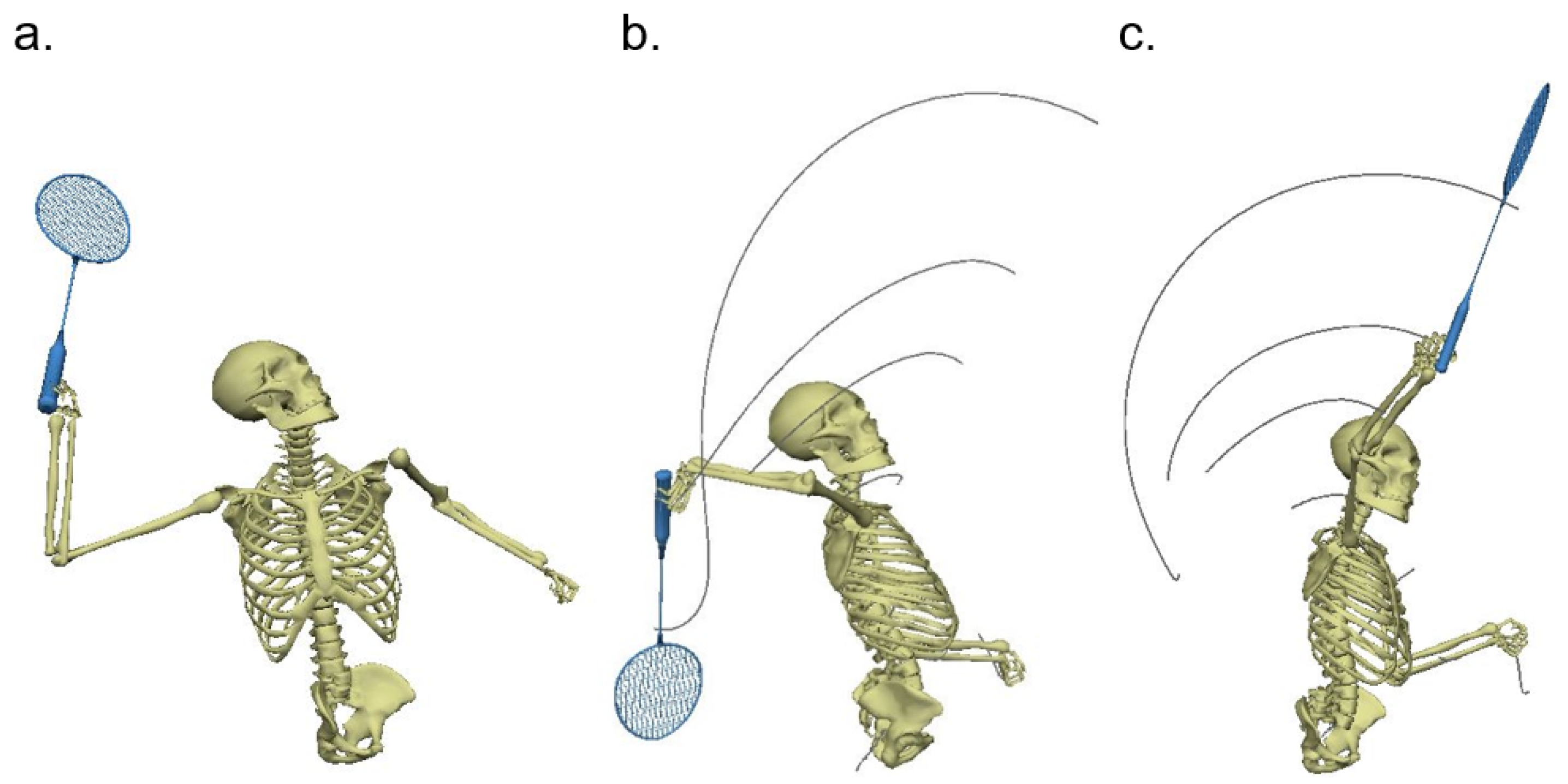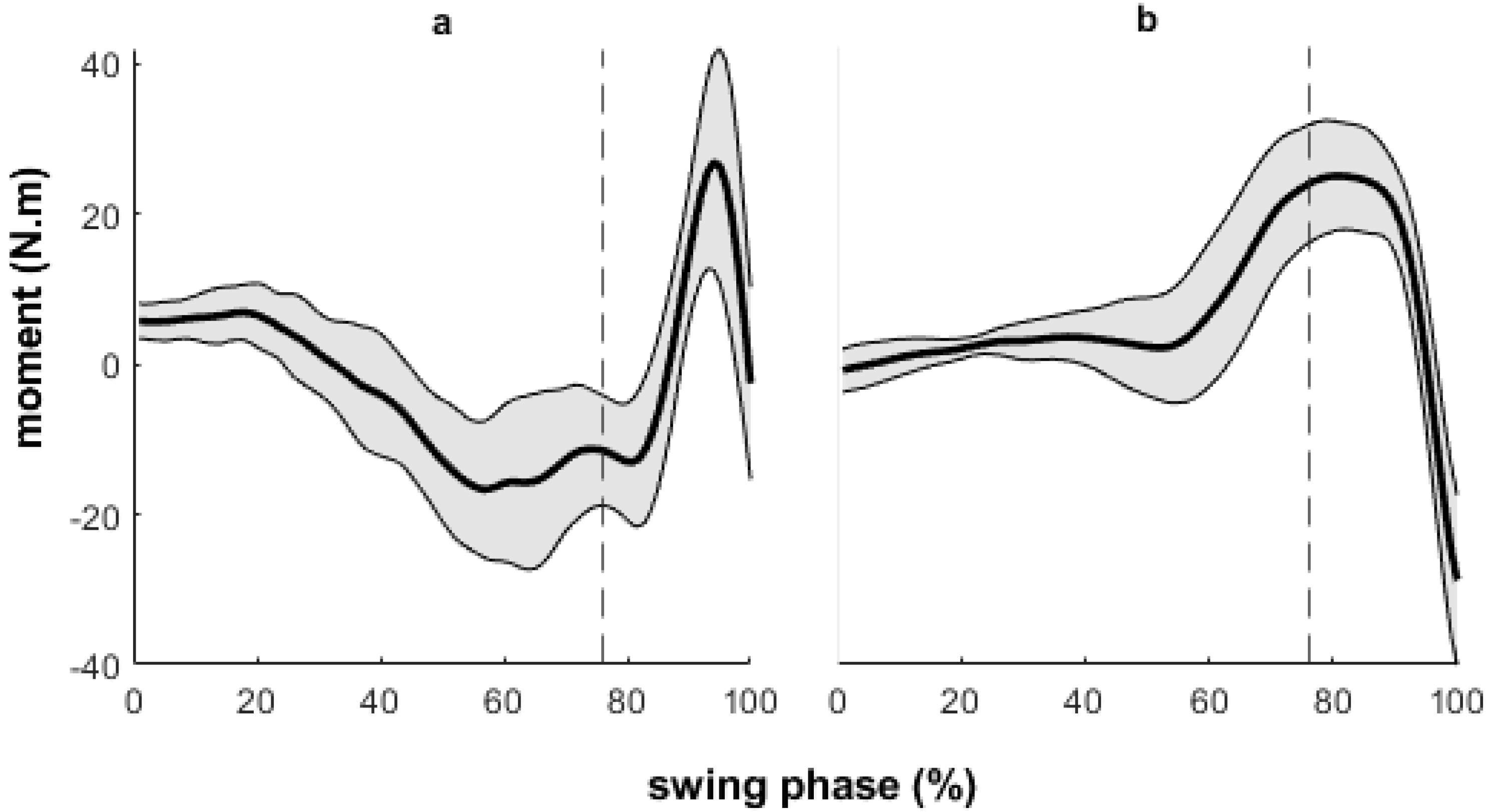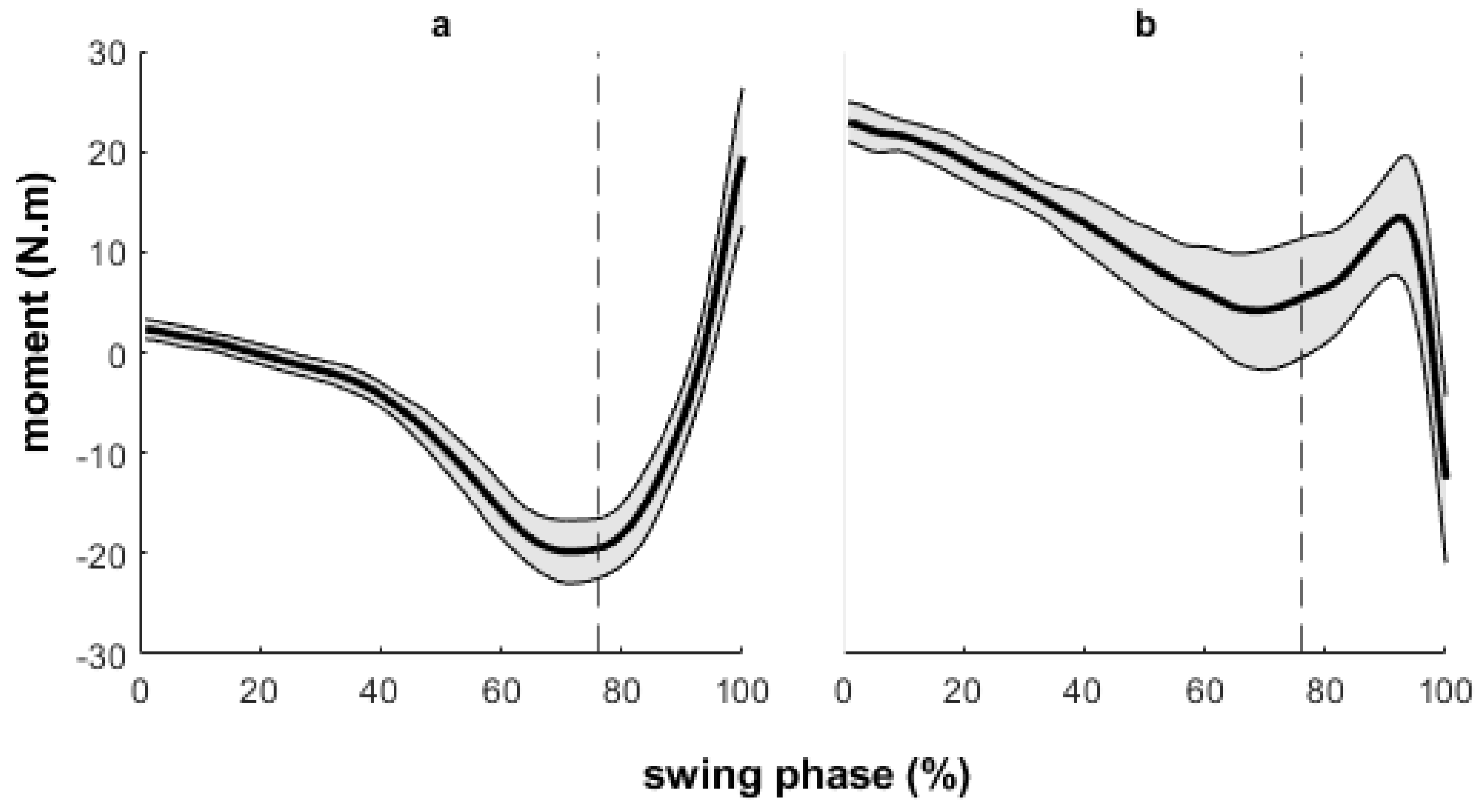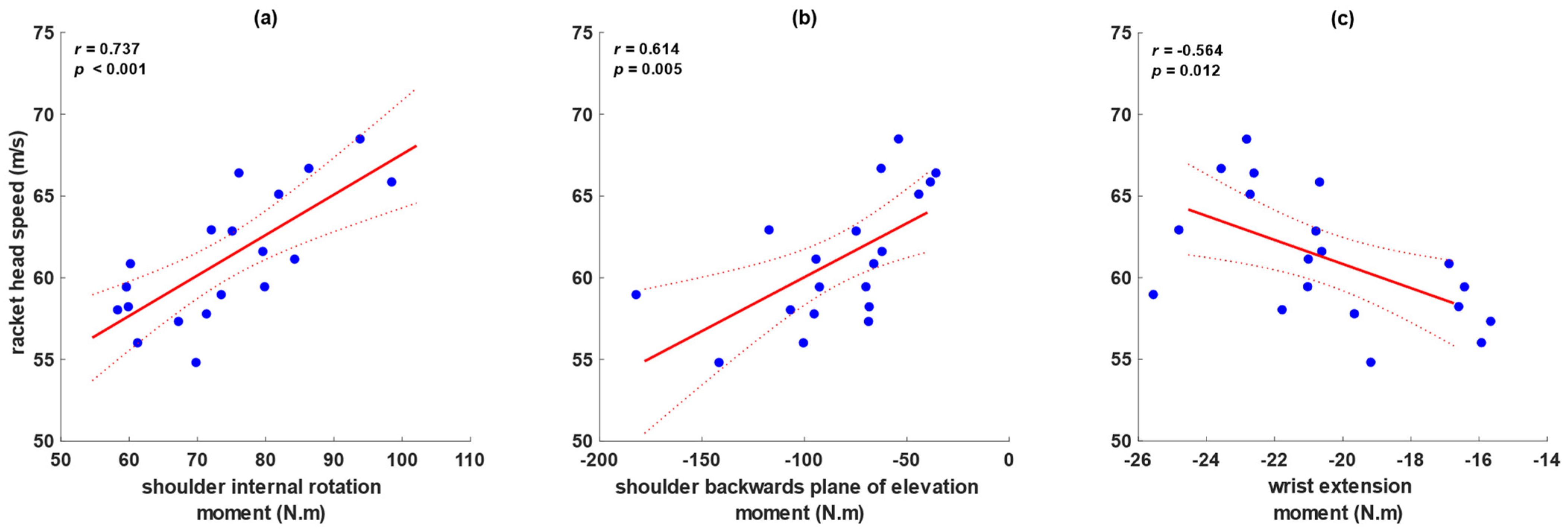Relationships between Racket Arm Joint Moments and Racket Head Speed during the Badminton Jump Smash Performed by Elite Male Malaysian Players
Abstract
1. Introduction
2. Materials and Methods
2.1. Participants
2.2. Data Collection
2.3. Data Analysis
3. Results
4. Discussion
5. Conclusions
Author Contributions
Funding
Institutional Review Board Statement
Informed Consent Statement
Data Availability Statement
Acknowledgments
Conflicts of Interest
References
- Lee, J.J.J.; Loh, W.P. A state-of-the-art review on badminton lunge attributes. Comput. Biol. Med. 2019, 108, 213–222. [Google Scholar] [CrossRef] [PubMed]
- Laffaye, G.; Phomsoupha, M.; Dor, F. Changes in the Game Characteristics of a Badminton Match: A Longitudinal Study through the Olympic Game Finals Analysis in Men’s Singles. J. Sports Sci. Med. 2015, 14, 584–590. [Google Scholar] [PubMed]
- Koike, S.; Harada, Y. Dynamic Contribution Analysis of Tennis-serve-motion in Consideration of Torque Generating Mode. Procedia Eng. 2014, 72, 97–102. [Google Scholar] [CrossRef]
- McErlain-Naylor, S.A.; Towler, H.; Afzal, I.A.; Felton, P.J.; Hiley, M.J.; King, M.A. Effect of racket-shuttlecock impact location on shot outcome for badminton smashes by elite players. J. Sports Sci. 2020, 38, 2471–2478. [Google Scholar] [CrossRef] [PubMed]
- King, M.; Towler, H.; Dillon, R.; McErlain-Naylor, S. A Correlational Analysis of Shuttlecock Speed Kinematic Determinants in the Badminton Jump Smash. Appl. Sci. 2020, 10, 1248. [Google Scholar] [CrossRef]
- Ramasamy, Y.; Osman, J.; Sundar, V. Ground Reaction Force and Kinematics of Forehand Jumping Smash Among Elite Malaysian Badminton Players. In Proceedings of the 37th International Society of Biomechanics in Sport Conference, Oxford, OH, USA, 21–25 July 2019; Volume 37, pp. 173–176. [Google Scholar]
- Ramasamy, Y.; Usman, J.; Sundar, V.; Towler, H.; King, M. Kinetic and kinematic determinants of shuttlecock speed in the forehand jump smash performed by elite male Malaysian badminton players. Sports Biomech. 2021, 1–16. [Google Scholar] [CrossRef] [PubMed]
- Dutton, M.; Gray, J.; Prins, D.; Divekar, N.; Tam, N. Overhead throwing in cricketers: A biomechanical description and playing level considerations. J. Sports Sci. 2020, 38, 1096–1104. [Google Scholar] [CrossRef]
- Fleisig, G.S.; Barrentine, S.W.; Zheng, N.; Escamilla, R.F.; Andrews, J.R. Kinematic and kinetic comparison of baseball pitching among various levels of development. J. Biomech. 1999, 32, 1371–1375. [Google Scholar] [CrossRef]
- Peploe, C.; McErlain-Naylor, S.; Harland, A.; King, M. Relationships between technique and bat speed, post-impact ball speed, and carry distance during a range hitting task in cricket. Hum. Mov. Sci. 2019, 63, 34–44. [Google Scholar] [CrossRef]
- Worthington, P.J.; King, M.A.; Ranson, C.A. Relationships between fast bowling technique and ball release speed in cricket. J. Appl. Biomech. 2013, 29, 78–84. [Google Scholar] [CrossRef]
- Koike, S.; Hashiguchi, T. Dynamic Contribution Analysis of Badminton-smash-motion with Consideration of Racket Shaft Deformation (A Model Consisted of Racket-side Upper Limb and a Racket). Procedia Eng. 2014, 72, 496–501. [Google Scholar] [CrossRef][Green Version]
- Rasmussen, J.; Kwan, M.M.S.; Andersen, M.S.; de Zee, M. Analysis of segment energy transfer using musculoskeletal models in a high speed badminton stroke. In Proceedings of the 9th International Symposium on Computer Methods in Biomechanics and Biomedical Engineering, CMBBE2010, Valencia, Spain, 24–27 February 2010; Available online: https://vbn.aau.dk/en/publications/analysis-of-segment-energy-transfer-using-musculoskeletal-models- (accessed on 30 January 2021).
- De Leva, P. Adjustments to Zatsiorsky-Seluyanov’s segment inertia parameters. J. Biomech. 1996, 29, 1223–1230. [Google Scholar] [CrossRef]
- Kwan, M.; Andersen, M.S.; Cheng, C.-L.; Tang, W.-T.; Rasmussen, J. Investigation of high-speed badminton racket kinematics by motion capture. Sports Eng. 2010, 13, 57–63. [Google Scholar] [CrossRef]
- Baltzopoulos, V. Inverse dynamics, joint reaction forces and loading in the musculoskeletal system: Guidelines for correct mechanical terms and recommendations for accurate reporting of results. Sports Biomech. 2021, 1–14. [Google Scholar] [CrossRef]
- C-Motion, “Visual 3D,” 2015. Available online: https://c-motion.com/v3dwiki/index.php/Inverse_Dynamics (accessed on 20 January 2021).
- Wu, G.; Van Der Helm, F.C.; Veeger, H.E.J.; Makhsous, M.; Van Roy, P.; Anglin, C.; Nagels, J.; Karduna, A.R.; McQuade, K.; Wang, X.; et al. ISB recommendation on definitions of joint coordinate systems of various joints for the reporting of human joint motion—Part II: Shoulder, elbow, wrist and hand. J. Biomech. 2005, 38, 981–992. [Google Scholar] [CrossRef]
- Elliott, B.C.; Marshall, R.N.; Noffal, G.J. Contributions of Upper Limb Segment Rotations during the Power Serve in Tennis. J. Appl. Biomech. 1995, 11, 433–442. [Google Scholar] [CrossRef]
- Hinkle, D.E.; Wiersma, W.; Jurs, S.G. Applied Statistics for the Behavioral Sciences; Houghton Mifflin College Division: Boston, MA, USA, 2003. [Google Scholar]
- Long, J.; Cliff, N. Confidence intervals for Kendall’s tau. Br. J. Math. Stat. Psychol. 1997, 50, 31–41. [Google Scholar] [CrossRef]
- Harrison, A.J.; McErlain-Naylor, S.A.; Bradshaw, E.J.; Dai, B.; Nunome, H.; Hughes, G.T.; Kong, P.W.; Vanwanseele, B.; Vilas-Boas, J.P.; Fong, D.T.P. Recommendations for statistical analysis involving null hypothesis significance testing. Sports Biomech. 2020, 19, 561–568. [Google Scholar] [CrossRef]
- Rusdiana, A.; Subarjah, H.; Badruzaman, B.; Budiman, D.; Wibowo, R.; Nurjaya, D.R.; Pramutadi, A.; Mustari, A.; Kusdinar, Y.; Syahid, A. Kinetics Analysis of Overhead Standing Smash in Badminton. J. Pendidik. Jasm. DAN Olahraga 2021, 6, 81–88. [Google Scholar] [CrossRef]
- Hirashima, M.; Yamane, K.; Nakamura, Y.; Ohtsuki, T. Kinetic chain of overarm throwing in terms of joint rotations revealed by induced acceleration analysis. J. Biomech. 2008, 41, 2874–2883. [Google Scholar] [CrossRef]
- Seroyer, S.T.; Nho, S.J.; Bach, B.R.; Bush-Joseph, C.A.; Nicholson, G.P.; Romeo, A. The Kinetic Chain in Overhand Pitching: Its Potential Role for Performance Enhancement and Injury Prevention. Sports Health A Multidiscip. Approach 2010, 2, 135–146. [Google Scholar] [CrossRef] [PubMed]
- Rogowski, I.; Creveaux, T.; Cheze, L.; Mace, P.; Dumas, R. Effects of the Racket Polar Moment of Inertia on Dominant Upper Limb Joint Moments during Tennis Serve. PLoS ONE 2014, 9, e104785. [Google Scholar] [CrossRef]
- Kwan, M.; Cheng, C.-L.; Tang, W.-T.; Rasmussen, J. Measurement of badminton racket deflection during a stroke. Sports Eng. 2010, 12, 143–153. [Google Scholar] [CrossRef]
- Koike, S.; Ishikawa, T.; Willmott, A.P.; Bezodis, N.E. Direct and indirect effects of joint torque inputs during an induced speed analysis of a swinging motion. J. Biomech. 2019, 86, 8–16. [Google Scholar] [CrossRef] [PubMed]





| Variable | Mean | Standard Deviation | r/(τb) | 95% CI | p | |||
|---|---|---|---|---|---|---|---|---|
| Lower | Upper | |||||||
| Moment | Shoulder | Backward plane of elevation | −82.92 | 36.57 | 0.614 | 0.221 | 0.835 | 0.005 * |
| Forward plane of elevation | 85.58 | 15.42 | −0.141 | −0.559 | 0.335 | 0.565 | ||
| Elevation | −50.15 | 33.26 | −0.228 | −0.261 | 0.066 | 0.172 | ||
| Depression | 43.72 | 23.22 | 0.476 | 0.028 | 0.765 | 0.039 | ||
| Internal rotation | 74.13 | 11.70 | 0.737 | 0.424 | 0.892 | <0.001 * | ||
| External rotation | −24.49 | 11.63 | −0.156 | −0.570 | 0.321 | 0.524 | ||
| Elbow | Flexion | 28.31 | 14.44 | −0.428 | −0.739 | 0.0312 | 0.067 | |
| Extension | −23.92 | 7.45 | −0.005 | −0.458 | 0.450 | 0.985 | ||
| Pronation | 6.56 | 0.308 | 0.308 | −0.170 | 0.669 | 0.199 | ||
| Supination | −7.75 | 2.64 | −0.379 | −0.711 | 0.090 | 0.109 | ||
| Wrist | Flexion | 20.90 | 7.04 | 0.125 | −0.349 | 0.548 | 0.610 | |
| Extension | −20.44 | 3.00 | −0.564 | −0.810 | −0.147 | 0.012 * | ||
| Radial deviation | −18.47 | 4.25 | −0.495 | −0.775 | −0.053 | 0.031 | ||
| Ulnar deviation | 1.51 | 0.98 | 0.291 | −0.188 | 0.658 | 0.226 | ||
Publisher’s Note: MDPI stays neutral with regard to jurisdictional claims in published maps and institutional affiliations. |
© 2022 by the authors. Licensee MDPI, Basel, Switzerland. This article is an open access article distributed under the terms and conditions of the Creative Commons Attribution (CC BY) license (https://creativecommons.org/licenses/by/4.0/).
Share and Cite
Ramasamy, Y.; Sundar, V.; Usman, J.; Razman, R.; Towler, H.; King, M.A. Relationships between Racket Arm Joint Moments and Racket Head Speed during the Badminton Jump Smash Performed by Elite Male Malaysian Players. Appl. Sci. 2022, 12, 880. https://doi.org/10.3390/app12020880
Ramasamy Y, Sundar V, Usman J, Razman R, Towler H, King MA. Relationships between Racket Arm Joint Moments and Racket Head Speed during the Badminton Jump Smash Performed by Elite Male Malaysian Players. Applied Sciences. 2022; 12(2):880. https://doi.org/10.3390/app12020880
Chicago/Turabian StyleRamasamy, Yuvaraj, Viswanath Sundar, Juliana Usman, Rizal Razman, Harley Towler, and Mark A. King. 2022. "Relationships between Racket Arm Joint Moments and Racket Head Speed during the Badminton Jump Smash Performed by Elite Male Malaysian Players" Applied Sciences 12, no. 2: 880. https://doi.org/10.3390/app12020880
APA StyleRamasamy, Y., Sundar, V., Usman, J., Razman, R., Towler, H., & King, M. A. (2022). Relationships between Racket Arm Joint Moments and Racket Head Speed during the Badminton Jump Smash Performed by Elite Male Malaysian Players. Applied Sciences, 12(2), 880. https://doi.org/10.3390/app12020880







